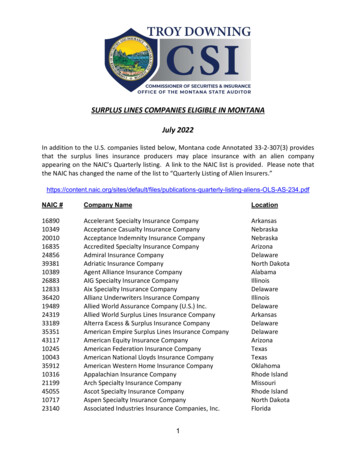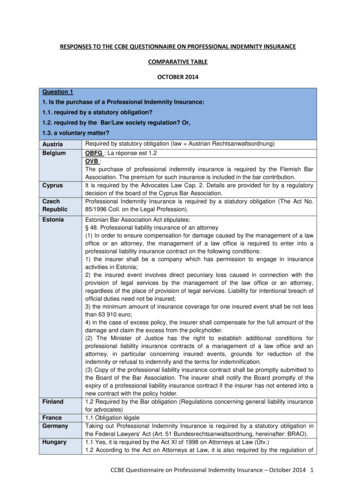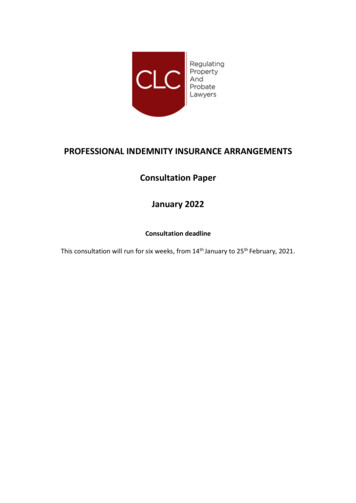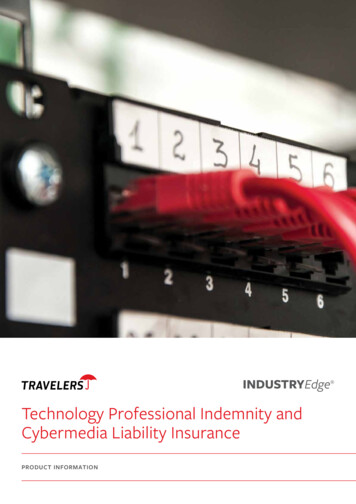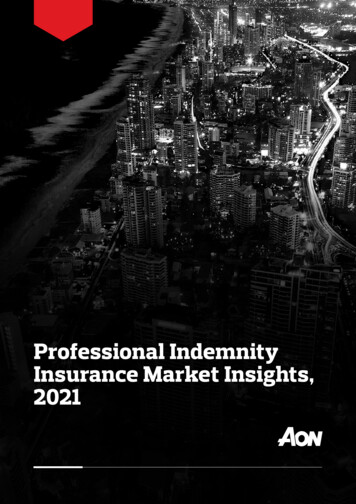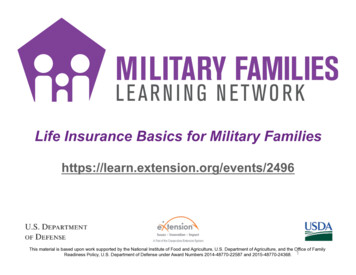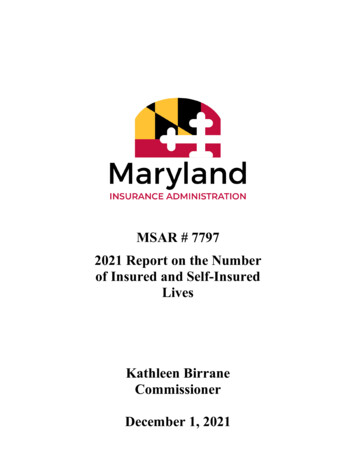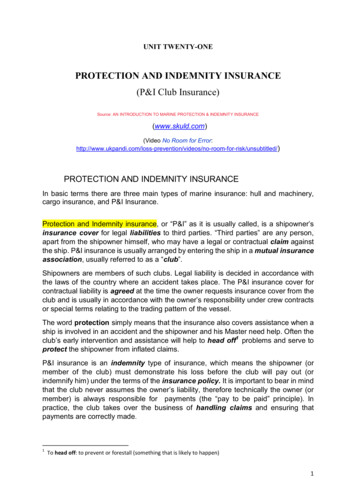
Transcription
UNIT TWENTY-ONEPROTECTION AND INDEMNITY INSURANCE(P&I Club Insurance)Source: AN INTRODUCTION TO MARINE PROTECTION & INDEMNITY INSURANCE(www.skuld.com)(Video No Room for s/no-room-for-risk/unsubtitled/)PROTECTION AND INDEMNITY INSURANCEIn basic terms there are three main types of marine insurance: hull and machinery,cargo insurance, and P&I Insurance.Protection and Indemnity insurance, or “P&I” as it is usually called, is a shipowner’sinsurance cover for legal liabilities to third parties. “Third parties” are any person,apart from the shipowner himself, who may have a legal or contractual claim againstthe ship. P&I insurance is usually arranged by entering the ship in a mutual insuranceassociation, usually referred to as a “club”.Shipowners are members of such clubs. Legal liability is decided in accordance withthe laws of the country where an accident takes place. The P&I insurance cover forcontractual liability is agreed at the time the owner requests insurance cover from theclub and is usually in accordance with the owner’s responsibility under crew contractsor special terms relating to the trading pattern of the vessel.The word protection simply means that the insurance also covers assistance when aship is involved in an accident and the shipowner and his Master need help. Often theclub’s early intervention and assistance will help to head off1 problems and serve toprotect the shipowner from inflated claims.P&I insurance is an indemnity type of insurance, which means the shipowner (ormember of the club) must demonstrate his loss before the club will pay out (orindemnify him) under the terms of the insurance policy. It is important to bear in mindthat the club never assumes the owner’s liability, therefore technically the owner (ormember) is always responsible for payments (the “pay to be paid” principle). Inpractice, the club takes over the business of handling claims and ensuring thatpayments are correctly made.1To head off: to prevent or forestall (something that is likely to happen)1
Ex. 1 Pair work: Discuss the bolded terms in the text above insurance cover liabilities claim mutual insurance association, “club” etc.Ex. 2 Supply the missing words:In basic terms there are three main types of marine insurance: Hull and machinery, cargoinsurance, and .Protection and Indemnity insurance, or “P&I” as it is usually called, is a shipowner’sinsurance for legal liabilities to third parties. “Third parties” are any person,apart from the shipowner himself, who may have a legal or contractualagainst the ship. P&I insurance is usually arranged by entering the ship in ainsurance association, usually referred to as a “ ”.are members of such clubs. Legal is decided in accordancewith the laws of the country where an takes place. The P&I insurance coverfor liability is agreed at the time the owner requests insurance cover fromthe club and is usually in accordance with the owner’s under crew contractsor special terms relating to the trading pattern of the vessel.The word protection simply means that the insurance also covers when aship is involved in an accident and the shipowner and his Master need help. Often the club’searly intervention and assistance will help to problems and serve to protectthe shipowner from inflated claims.P&I insurance is an type of insurance, which means the shipowner (ormember of the club) must demonstrate his loss before the club will pay out (orhim) under the terms of the insurance policy. It is important to bear in mindthat the club never assumes the , therefore technically the owner (ormember) is always responsible for (the “pay to be paid” principle). Inpractice, the club takes over the business of claims and ensuring thatpayments are correctly made.Ex. 3 Find the verbs in the above text that take the following nouns as theirobject:a claim against the shipthe ship in a mutual insurance associationlegal liabilityP&I insurance cover for contractual liabilityassistanceproblems2
shipowner from claimsdemonstrate the lossthe owner’s liabilityclaimspaymentsRUNNING DOWN CLAUSE (RDC) AND FIXED OR FLOATING OBJECTS (FFO)The P&I cover may include liability for collisions (“RDC”), for example when themember’s ship is in collision with another ship, or when the entered ship strikes afixed object, i.e. a quay, dock or buoy (“FFO”). However, collision and strikingliabilities are often included in the ship’s hull and machinery cover, for instance underthe Norwegian Insurance Plan. Therefore, it is important for a Master to ascertainwhether his vessel’s collision insurance (collision between ships) and strikinginsurance (i.e. when a ship strikes a fixed or floating object which is not another ship)is covered under his P&I policy or under his hull and machinery policy. To be safe, itis always wise for a Master to inform the P&I club, or the club correspondent, if hisvessel is in collision with another vessel or a fixed object.DEATH AND PERSONAL INJURY ON BOARD THE VESSELP&I insurance covers an owner’s liability for all deaths, personal injuries andillnesses which occur on board, including death or injury to crew, passengers,stevedores, pilots and visitors to the ship.REPATRIATION OF SICK OR INJURED CREW AND HOSPITAL EXPENSESP&I insurance also covers a shipowner’s liability to pay for the costs of repatriatingcrew members who become sick or are injured on board. The insurance also coversthe crew’s hospital bills and costs of sending replacement personnel to the ship ifnecessary.LOSS OF CREW MEMBERS’ PERSONAL EFFECTSP&I insurance also covers the owner’s liability for loss of crew belongings in cases ofshipwreck or fire on board. The cover only applies to items which are deemed to bereasonable for any crew member to have with him on board. A crew member travellingwith unusually expensive items, such as laptop computers, gold watches etc shouldmake sure that he has such items separately insured.1. Ex. 4 Match the explanation in the left-hand column withthe correspondent heading in the right-hand columnI.The P&I cover may include liability for collisions (“RDC”),for example when the member’s ship is in collision withanother ship, or when the entered ship strikes a fixedobject, i.e. a quay, dock or buoy (“FFO”). However, collisiona. LOSS OF CREWMEMBERS’PERSONALEFFECTS3
and striking liabilities are often included in the ship’s hulland machinery cover, for instance under the NorwegianInsurance Plan. Therefore, it is important for a Master toascertain whether his vessel’s collision insurance (collisionbetween ships) and striking insurance (i.e. when a shipstrikes a fixed or floating object which is not another ship)is covered under his P&I policy or under his hull andmachinery policy. To be safe, it is always wise for a Masterto inform the P&I club, or the club correspondent, if hisvessel is in collision with another vessel or a fixed object.II.P&I insurance covers an owner’s liability for all deaths,personal injuries and illnesses which occur on board,including death or injury to crew, passengers, stevedores,pilots and visitors to the ship.III.P&I insurance also covers a shipowner’s liability to pay forthe costs of repatriating crew members who become sickor are injured on board. The insurance also covers thecrew’s hospital bills and costs of sending replacementpersonnel to the ship if necessary.IV.P&I insurance also covers the owner’s liability for loss ofcrew belongings in cases of shipwreck or fi re on board. Thecover only applies to items which are deemed to bereasonable for any crew member to have with him onboard. A crew member travelling with unusually expensiveitems, such as laptop computers, gold watches etc shouldmake sure that he has such items separately insured.b. DEATH ANDPERSONALINJURY ONBOARD THEVESSELc. RUNNING DOWNCLAUSE ANDFIXED ORFLOATINGOBJECTSd. REPATRIATIONOF SICK ORINJURED CREWAND HOSPITALEXPENSESEx. 5 Group work: Discuss the following P&I insurance concepts (terms) in yourgroup: RUNNING DOWN CLAUSE (RDC)STRIKING FIXED OR FLOATING OBJECTS (FFO)DEATH AND PERSONAL INJURY ON BOARD THE VESSELREPATRIATION OF SICK OR INJURED CREW AND HOSPITAL EXPENSESLOSS OF CREW MEMBERS’ PERSONAL EFFECTSLOSS OF OR DAMAGE TO CARGOOne of the major functions of Protection and Indemnity insurance is to cover ashipowner, or the charterer of a ship, for liability for loss of, or damage to, cargo ifthere has been a breach of the contract of carriage. This breach of contract usuallymeans that something has happened to the cargo while it was on board the ship or4
being loaded or discharged, and for which the owner or charterer can be heldresponsible, i.e. shortage or damage to the cargo. Therefore,if a Bill of Lading issigned and states that 10,000 sacks of potatoes are loaded and only 9,500 aredischarged – then the ship (the owner or charterer, or both) may be held liable for theloss. Usually, the cargo insurers will pay the person or company who owns the cargo(the receiver) for the costs of loss or damage to that cargo. The cargo underwriterswill then seek to recover their losses from the shipowner or charterer. The P&I clubwill usually take over the handling of such claims on behalf of the assured. This isone of the reasons why evidence in the form of documentation, copies of the log book,surveys of damaged cargo, copies of tally books, dated photos of loading in the rain etcare very important in establishing the exact reason for the damage. There are certaindefences open to the shipowner, such as being able to establish that the packaging ofthe cargo was not good enough to protect it during transportation. Ensure any damageis surveyed and recorded.Damage to cargo is the most frequent type of liability that confronts a shipowner.Unfortunately, cargo damage is often caused by small mistakes.An important function of the Bill of Lading (B/L) is to describe the condition and quantityof the cargo as received on board. If the cargo is discharged in a different condition, orin lesser quantity than that entered on the B/L, the shipowner may be held liable for thedamage or shortage.OTHER P&I COVERED RISKSOther risks covered include liability for stowaways, liability for oil pollution and othertypes of pollution and legal liability for wreck removal if the ship sinks and is blockingfree navigation for other vessels. In short, P&I insurance is a very comprehensivetype of insurance cover which makes it easier for a shipowner or charterer to trade ininternational shipping transportation. P&I is as important to a prudent shipowner as hisHull and Machinery insurance cover.SUMMARYP&I is a special type of marine insurance. It is a liability insurance that a prudentshipowner, manager or charterer needs, particularly if the ship is employed ininternational trade. P&I insurance covers a shipowner or charterer for liabilities andlosses in direct connection with the operation of the ship. We often use the term “thirdparty insurance” to explain P&I.Ex. 6 Supply the missing word in the right place in the sentenceLOSS OF OR DAMAGE TO CARGOOne of the major functions of Protection and Indemnity insurance is to a shipowner, or the chartererof a ship, for or loss of, or damage to, cargo if there has been a of the contract of carriage. (cover,liability, breach)This breach of contract usually means that something has happened to the cargo while it was onboard the ship or being loaded or discharged, and for which the owner or can be held responsible,i.e. or damage to the cargo. (charterer, shortage)Therefore, if a Bill of Lading is and states that 10,000 sacks of potatoes are loaded and only 9,500 aredischarged – then the ship (the owner or, or both) may be held for the loss. (signed, charterer, liable)5
Usually, the will pay the person or company who the cargo (the receiver) for the costs of or damageto that cargo. (cargo insurers, owns, loss)The cargo underwriters will then to their losses from the shipowner or charterer. (seek, recover)The club will usually take over the of such claims on behalf of the. (P&I, handling, assured)This is one of the reasons why in the form of documentation, copies of the, surveys of damagedcargo, copies of, dated photos of loading in the rain etc are very important in the exact reason for thedamage. (evidence, log book, tally books, establishing)There are certain open to the shipowner, such as being able to that the packaging of the cargo wasnot good enough to protect it during. (defences, establish, transportation)any damage is and recorded. (ensure, surveyed)Damage to cargo is the most frequent type of that a shipowner. (liability, confronts)An important function of the is to describe the condition and quantity of the cargo as on board. (Billof Lading (B/L), received)If the cargo is discharged in a different condition, or in lesser quantity than that on the B/L, theshipowner may be liable the damage or. (entered, held, for, shortage)OTHER P&I COVERED RISKSOther covered include liability for, liability for oil pollution and other types of pollution and wreckremoval if the ship sinks and is blocking free navigation for other. (risks, stowaways, legal liabilityfor, vessels)In short, P&I insurance is a very type of which makes it easier for a or charterer to in internationalshipping transportation. (comprehensive, insurance cover, shipowner, trade)P&I is as important to a shipowner as his insurance cover. (prudent, Hull and Machinery)6
Ex 7 Supply the missing termsHOW MUTUAL P&I INSURANCEACTUALLY WORKSIf a shipowner or requires P&I insurance in connection with the operation of a vessel, he maycontact a P&I association. A Protection and association is often referred to as a “club”.This is because the members club together to insure similar risks on a mutual .insurance means that the members of the club are its owners and share in its results.Therefore are also mutual and estimated for a given policy year and finally decided whenthe year is closed which is minimum (but also normally) three years later. are thereforereferred to as “calls”. An Estimated Total Call is calculated for any given ship. may be chargedall in advance, the full Estimated Total Call or divided into Advance and Supplementary Calls. The benefitof charging Estimated Total Call the first policy year is that the member may be able to fully budget his. Before the policy year is finally closed, the club can decide to cover the and tocharge an Additional Supplementary Call. The reason why accounts are kept open is that cases continueto develop and could over time become more, or less, expensive than initially anticipated. In a P&Imembers come together to insure similar risks on a mutual basis.Accordingly, Estimated Total Calls could also be reduced. A mutual club may wish to increase its reserves,but does not make “profits“ since there are no owners other than the members themselves.The club has a Board of Directors who, naturally, expect the managers to do a best possible job. Inpractice, this means providing insurance cover and first-class service, at the lowest possible cost.P&I (and Hull & Machinery) premiums are important parts of the overall operational costs, together withcrewing, maintenance, store and supplies of fuel, etc.The mutual system is occasionally challenged by what is referred to as “fixed premium facilities”. However,the know-how and claims handling expertise of the clubs, together with the universalacceptance of a club Letter of Undertaking, have so far made the clubs the preferred choice for themajority of owners and charterers.There are many ways of measuring the performance of a P&I club. If members collectively have fewclaims – and club management does a good job of handling those claims on behalf of the members– costs can be kept to a minimum (heavy losses and many claims lead to higher premiums). But not eventhe world’s most qualityconscious operator, and most extensive loss prevention programmes,can eliminate claims altogether. Therefore, the member depends on his P&I insurance to give him thesecurity of being able to trade in a competitive market.7
Ex 8 Match the text on the left with the corresponsing headings o the rightHOW YOU CAN HELPa. No “back letters”1. Inspect cargo as it comes on board.b. Put it in writing2. If you receive damaged cargo or less cargo than declared forc. Seaworthinessshipment, make sure the damage or shortage is recorded on theMate’s Receipt for clausing of the B/L. Notify the shipper andcharterers that you intend to alter the shipping document to reflectyour observations.3. Do not give authority to sign a clean B/L in exchange for a “backd. Record thedamagee. Is it damaged?f.letter” or indemnity – such action can be fraudulent and may makethe P&I insurance invalid.Recordinspectionsg. Safely stowed4. The tallying of cargo during loading and discharge is a useful way toavoid or limit shortfalls.5. Inspect the cargo and record any differences6. Record in the log book inspections of cargo holds undertaken by theh. Survey thedamagei.people awayship’s officers or crew during the voyage.7. Make sure that cargo is carefully and safely loaded, stowed,separated, carried and discharged.8. In Time Charters applicable to dry cargo vessels, the responsibilityfor load, stow, trim and discharge operations is sometimestransferred from the shipowners to the charterers. Therefore, if yousee reason to interfere in the way the charterers, or their supercargo,stow or handle the cargo, make sure you carefully write down yourreason for objecting. Report your remarks to the ship’s owners. Inthis respect, photographs can be very useful.Keep unidentifiedj.Tallyk. Protestl.Log it!m. Surrender ofcargon. Weather reportso. Keep wet cargoseparate9. Remember the Master always has the final responsibility for theseaworthiness of the vessel. Safely stow the cargo.10. If you suspect that your cargo may have been damaged during thevoyage, inform the ship’s owners. They should then request Skuld toarrange for a surveyor to meet you at your destination. Alternatively,you can always contact your local Skuld correspondent. They areinstructed to immediately assist you in any way.11. In case of heavy weather, keep a copy of any meteorological reportsor warnings, and properly record the conditions in the ship’s log. Thisparticularly applies to adverse sea conditions which may causedamage to the goods on board.12. Lodge a sea protest at your next port of call and make sure a logextract showing relevant entries is attached. Co-operate as much aspossible with the surveyor appointed on behalf of the owners at thedestination. If possible, the Master should attend the survey of thedamaged cargo himself, or have his Chief Officer attend.13. Consult the local Skuld correspondent before giving permission forunauthorised surveyors or lawyers to board the vessel. Protect theowners’ interests by posting a gangway watch and, if necessary,prevent unauthorised people from boarding the vessel. Keep copiesof weather reports8
14. Damage can be reduced by the immediate separation of wet cargo(e.g. wet fertiliser) from the rest of the cargo.15. Record in the log book any known cause of damage to the cargo,e.g. freak waves, heavy weather (particularly if you reduce speed oralter course) etc. Also note any other event that may have a bearingon the cargo carried, e.g. ventilation to avoid condensation, relevantdewpoint readings in the cargo spaces and outside etc.16. Cargo must only be delivered to the holder of the original B/L or hisagent. This important formality is usually attended to by the ship’sagents, but if you do fi nd yourself in a diffi cult or worrying situation,contact the local Skuld correspondent. Before leaving the subject ofdamage or loss to cargo, it might be appropriate to recall Article 3,paragraph 2:“Subject to the provisions of Article 4 of the Hague Rules,the carrier shall properly and carefully load, handle, stow,carry, keep, care for, and discharge the goods carried.”9
P&I insurance covers:Loss of lifeLoss or damage to cargo;Injury to crew members and others;Hospitalization of crewmembers in foreignports;Liabilities for damage to docks, cables(submerged or other), shore installations,navigation aids, bridges and other fixed ormovable properties, damage to property of anykind caused by excessive speed in harbor;Certain types of fines and pena1ties, andpractically all risks not covered by marineinsurance companies.Expenses incurred in repatriating crewmembers who have been hospitalized inforeign ports;Repatriation of crew members of stranded orlost vessel;Marine insurance companies and P&I, known as underwriters, indemnify the shipowner onlyfor damage and losses specified in the policy after the shipowner proves that such damage or loss hasoccurred. This is determined by surveys, entries in the log, reports and statements submitted by themaster.Making up proper reports and statements and getting statements from witnesses in case ofaccident or casualty to the vessel or cargo or injury to a person, serves an important purpose in theprotection of your company's interests. This is time-consuming labor, but it is a necessary evil, andone which cannot be avoided. Therefore, all reports and statements should be completed with theleast possible delay. All reports and statements should be clear, neat and legible.Logbook Entries. In each case of accident or loss, or of fire on board, collision or grounding,detailed entries should be made in the official log. In certain types of accidents, such as collision andgrounding, it is a good idea to make rough notes on a pad and enter them in the log in propersequence. If in doubt about whether to make an entry or not, a safe rule is to enter it in the log, butonly after it has been roughed out. Do not trust anything to memory. Write it down as soon aspossible after the occurrence, while it is still fresh in mind.The Reports and Statements. Your company may want reports on special forms, on allaccidents, even those which do not ordinarily require a comprehensive report or statement.In cases of injury to a person on the vessel, first aid should be rendered immediately. If inport, and it is thought necessary, a doctor should be called or the injured person should be sent to ahospital. Fill out Injury Reports and enter all details in the medical log, and, if a crew member isinvolved, in the official log.Accidents Going or Leaving Drydock. If your ship touches another vessel or craft, anaccident report should be made out. Due to the close quarters in some drydocks this type of accidentoccurs occasionally. If your vessel was using her engine, a copy of the logbook and bellbookcovering the time should also be made up. Names of tugs used and their positions around the vesselshould be shown on a diagram. The pilot should also make a statement. A similar report is necessary10
if the vessel strikes any part of the drydock. Statements may also be required from the officer onduty on the bridge and the man at the wheel and the lookout.Cargo Damage. Cargo damage is a constant problem. Usually, it is the chief officer who mustwrite a statement and make a report giving the reason for the damage. If it was caused by salt water,he should note in the statement that the hatches were properly battened down and the number of tarpsused on each. Provided all facts are correct, the statement and report are countersigned by you.An abstract of the log (six copies) covering the period of the heavy weather should be madeup. The weather must necessarily have been extra-ordinarily heavy - not the rough weather usuallyexpected on the voyage. The log should show what steps were taken to avoid heavy weather damageand to prevent laboring of the vessel - such as slowing down, changing course or ballasting. Suchentries in the log will be of assistance to your insurance department in fighting a claim made againstyour company for damage to cargo. Any repairs to the vessel for damage attributed to the heavyweather on that voyage should be noted in the logbook and in the statement.Collision with Another Vesse1. First of all, fill out the required form sending one copy toyour insurance department. A number of statements and reports will have to be made. Therefore starttaking notes immediately or put an officer on the job. Don't forget to serve notice on the master of theother vessel, that her company will be held responsible for all damage sustained by your vessel.Request the addressee of the letter to acknowledge its receipt. Chances are he will not do this, and hemay even refuse to accept the notice. In all probability he will serve you with the same kind of notice.Do not accept or acknowledge it even though you may have hit him amidships on a clear day whenhis vessel was at anchor! Never admit liabillity or that your vessel was at fault. Leave that to yourcompany insurance department if they think it necessary. Don't give out any information and don'tallow anyone, with the exception of the authorities' officials, to examine the logbooks or bellbooks.Note in your logbook and in your statement:(a) That you made certain as to whether anyone was injured on either vessel.(b) Whether the other vessel was in need of assistance. (Remember that if you can with safety youmust stand by her until she is reported out of danger).(c) That you had bilge soundings taken hourly or oftener, as thought necessary.(d) The extent of damage to your vessel as far as known.(e) The names of witnesses-men who were on deck at the time.QUESTIONS11
1.What does marine insurance indemnify the company against?2.What is covered by the Protection and Indemnity Clubs?3.Explain the terms “hospitalization” and “repatriation”.4.How does the Owner prove that the damage or loss has occurred?5.Who makes use of your reports or statements on the accidents, injuries, etc.?6.What information should be entered in the logbook?7.What should you do in case of an injury to a person on board?8.Why are accidents on going or leaving drydock or docks in general so frequent?9.What is the procedure followed in case of cargo damage?10.What should you do as master in such a case?11.What information on the weather during the accident should be entered in the log?12.Describe the procedures involved in reporting and recording the collision with another vessel.13.Why should you not admit any liability or a fault? Who is supposed to deal with it?14.What are the most important particulars to be noted in the ship's logbook or in the master'sstatement?EXERCISESI COMPREHENSION AND VOCABULARY1. Give the words or phrases referring to the definitions below:1) Company that indemnifies the Owner against damage to or loss of a vessel or cargo;()2. Societies covering the risks of loss of life, striking docks or shore installations, expatriationexpenses, hospitalization of crew, etc. ()3. Book where the important details of the voyage are entered every day; ()12
4. Ladder for boarding a ship; ()5. Putting into a port of refuge, i.e. a port other than those provided in the C/P or voyage)schedule; (6. Persons or company engaged in stowing cargo in the ship's holds; (7. Pieces of canvas for covering the hatches, etc.; ())8. Space in the ship where water, oil and moisture are drained; ()9. Expenses incurred by the Shipowner in connection with running the ship under a C/P orother contract; ()10. The act of throwing cargo and stores overboard in order to save the vesse1; ()2. Complete the letter below with the appropriate prepositional phrases (in brackets) and statewhat the Master's intention is: (AT THE SAME TIME, AT A LATER DATE, IN REPLY,HEREWITH, IN CONNECTION WITH)Repudiating responsibility in the collisionDear Sirs,13
to your letter dated 16.02.1986.the collisionbetween my vessel and your vessel off Hull, Irepudiate allresponsibility for the above collision and all the consequences arising therefrom.I hold you responsible for all damages caused to my vessel andfor all the relative consequences.I reserve my Owner's right to revert to this matter.Faithfully yours,Master, MV NUTCRACKERII GRAMMAR1. Supply the missing form of the verb in brackets: (ADVISE, ARISE, CAUSE, GET IN TOUCH,OCCUR, PROTECT)1. Disputes in the sea tradeas a result of the infringement of the contract ofcarriage, maritime regulations, and laws or as a consequence of accidents which at sea orin ports.2. The accidentsby the action of natural elements (wind, sea, current) or bymaritime perils (accidents such as collisions, striking docks, fire, explosion, stranding,engine breakdown, etc.)3. Exoneration clausethe Owners from certain risks such as errors innavigation and in the management of ships.4. As soon as an accident, the Master should the P&I Club's representativein the port and supply him with the necessary information and documents. At the sametime he mustwith the ship agent and the Owner.2. Supply the missing prepositions (Fire Report):MV ANA LUISA (SantosHamburg) presently berthedportreports fire hold sisal (Lloyd's Agents). ANA LUISA sailedSalvadorMay 10, Fortalezaher voyageNorth Europe. Vesselthis port general cargo and1600, May 11, fire was discoveredhold, apparently started sisal cargo. Initially crew used water and subsequentlyRecife,2315,loadedNo. 5carbon14
dioxide. As fire continued, vessel was divertedRecife, arriving0543 May12 and berthing0700 same day. Assistancefire brigade was provided andfire was finally extinguished1110 today. The hold is totally flooded and dischargeall cargo starting now.3. Cause III. Cause is also expressed by words (verbs, nouns) denoting cause or reason:1) The officer must write a statement and make a report giving the reason for the damage.2) The damage was caused by sal
international shipping transportation. P&I is as important to a prudent shipowner as his Hull and Machinery insurance cover. SUMMARY P&I is a special type of marine insurance. It is a liability insurance that a prudent shipowner, manager or charterer needs, particularly if the ship is employed in international trade.

